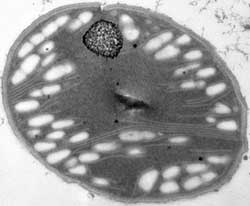 Cyanobacteria are oxygenic (oxygen-producing) photosynthetic prokaryotes that make significant contributions to the global biological solar energy conversion process. Oxygenic photosynthesis and nitrogen fixation are important metabolic processes that are at odds with each other, since the nitrogen-fixing enzyme, nitrogenase, is highly sensitive to oxygen. This project focuses on the strategies devised by the unicellular, nitrogen-fixing cyanobacteria belonging to the genus Cyanothece to permit nitrogen fixation and photosynthesis to coexist in the same cell. These organisms have developed a type of temporal regulation in which the two processes occur at different times throughtout a diurnal cycle. This includes very high levels of CO2 fixation during the light and storage of this product for later use in the dark. These aspects of carbon and nitrogen storage make Cyanothece almost unique among well-studied cyanobacteria and make them key candidates for genome sequencing. The analysis of gene structure and regulation in these organisms can provide tremendous information about how these photosynthetic unicellular organisms deal with one of the biosphere’s greatest juggling jobs. The sequencing of six Cyanothece genomes will enhance use of these organisms to study processes such as circadian rhythm, CO2 fixation and sequestration, nitrogen fixation, hydrogen production, metal bioremediation, and compartmentalization of metabolites. Cyanothece is also the target organism for a systems biology-based grand challenge project funded by the Environmental Molecular Science Laboratory (EMSL) at Pacific Northwest National Laboratory.
Cyanobacteria are oxygenic (oxygen-producing) photosynthetic prokaryotes that make significant contributions to the global biological solar energy conversion process. Oxygenic photosynthesis and nitrogen fixation are important metabolic processes that are at odds with each other, since the nitrogen-fixing enzyme, nitrogenase, is highly sensitive to oxygen. This project focuses on the strategies devised by the unicellular, nitrogen-fixing cyanobacteria belonging to the genus Cyanothece to permit nitrogen fixation and photosynthesis to coexist in the same cell. These organisms have developed a type of temporal regulation in which the two processes occur at different times throughtout a diurnal cycle. This includes very high levels of CO2 fixation during the light and storage of this product for later use in the dark. These aspects of carbon and nitrogen storage make Cyanothece almost unique among well-studied cyanobacteria and make them key candidates for genome sequencing. The analysis of gene structure and regulation in these organisms can provide tremendous information about how these photosynthetic unicellular organisms deal with one of the biosphere’s greatest juggling jobs. The sequencing of six Cyanothece genomes will enhance use of these organisms to study processes such as circadian rhythm, CO2 fixation and sequestration, nitrogen fixation, hydrogen production, metal bioremediation, and compartmentalization of metabolites. Cyanothece is also the target organism for a systems biology-based grand challenge project funded by the Environmental Molecular Science Laboratory (EMSL) at Pacific Northwest National Laboratory.
Principal Investigators: Himadri B. Pakrasi (Washington Univ.) and Louis A. Sherman (Purdue Univ.)